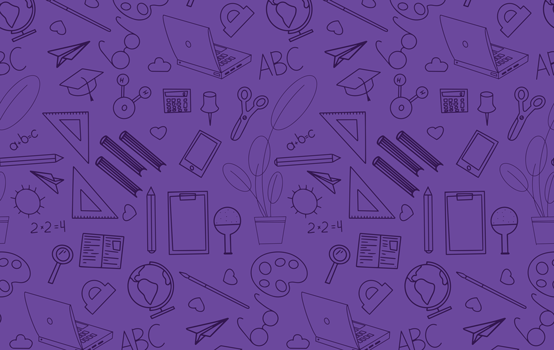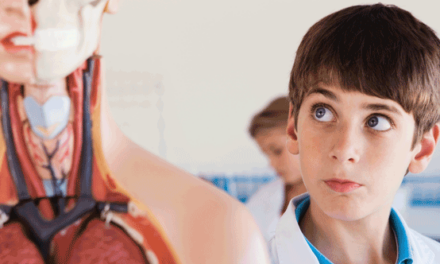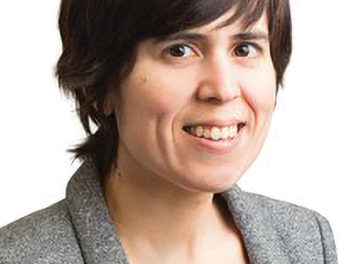A series of rigorous studies show that authentic, student-driven approaches to project-based learning improve student outcomes.
Deborah Peek-Brown has always believed in weaving project-based learning into her instruction. But when she looks back on the projects she integrated into her lessons early in her 30-year career as an elementary science teacher, she says that a lot was missing. “We did cookbook experiments that were usually just validating what we did in class,” she recalls. Today, Peek-Brown helps support other teachers in moving to a project-based approach in which projects drive the lesson, as opposed to being tacked on at the end. Students learn through asking authentic questions about real problems and creating projects that tackle those problems. “That power of ‘I can figure things out for myself,’ is such an important skill for kids to develop and one that they will use for the rest of their lives,” Peek-Brown says.
Project-based learning (PBL) is an educational approach in which students explore real-world problems through individual and group projects. When done well, it allows students to make sense of why content is useful and how it might be applied. The approach that Peek-Brown, an education specialist at Michigan State University, uses today to support elementary science teachers is one of four PBL programs studied in a new body of research that has generated strong evidence — based on “gold-standard” studies, using randomized control methods — showing that rigorous PBL improves student learning. (Research briefs for the studies are available at www.lucasedresearch.org/research/research-briefs.)
Funded by Lucas Education Research (which I lead) — a division of the George Lucas Educational Foundation — the research findings are the culmination of seven years of effort to develop and study rigorous PBL curricula and aligned supports used across grades and subjects. The studies were not meant to evaluate progressive education writ large, or even to evaluate all forms of PBL, but they did take a careful look at the effects of pairing high-quality project-based curriculum with the implementation of complementary instructional practices. Specifically, the findings, released in 2021, show that:
- Embedding project-based learning in Advanced Placement courses increased the probability of students earning a passing score on AP tests by about 8 percentage points in the first year and 10 percentage points after teachers had two years of experience with the project-based curriculum (Saavedra, Liu, et al., 2021).
- Middle school students in California who learned science with a project-based curriculum outperformed their peers by 11 percentage points on a science assessment and also did better on the state’s end-of-year math and English language arts assessments (Deutscher et al., 2021).
- Third-grade students in Michigan who used an interdisciplinary project-based science curriculum performed 8 percentage points better than peers in traditional classes on a key science assessment (Krajcik et al., 2021).
- Second-grade students in Michigan who used a project-based social studies and literacy curriculum demonstrated five to six more months of learning in social studies and two to three more months in informational reading than a comparison group (Duke et al., 2020).
Taken together, these studies provide clear evidence that rigorous project-based learning has a strong effect on student achievement. The research also found that these PBL programs improved certain aspects of social and emotional learning, and these effects were consistent across racial and socio-economic groups.
Questions and challenges about PBL
The definitional challenge
It has taken many years, even decades, to develop an evidence base that focuses on the building blocks of effective PBL, largely because PBL itself has been difficult to define with precision, and it has meant different things to different people. Historically, for instance, many schools have assigned students to complete projects at the end of a unit — perhaps by doing an experiment or making a simple poster or shoebox diorama — rather than letting projects themselves drive student learning throughout the unit. Should that be called PBL, or is it something else entirely (i.e., the assignment of projects as a means of consolidating previous learning)?
It has taken many years, even decades, to develop an evidence base that focuses on the building blocks of effective PBL, largely because PBL itself has been difficult to define with precision.
In my own work, I’ve often heard educators say of good PBL instruction, “It’s hard to describe, but you know it when you see it.” I’ve also been in plenty of classrooms in which the instruction was called project-based learning but didn’t actually reflect the core practices that many of us associate with PBL — that is, the instruction didn’t allow for student inquiry or self-discovery, didn’t address authentic problems that young people care about, and wasn’t tied to key teaching and learning standards. Similarly, advocates have often disagreed with one another over the extent to which PBL requires students to drive their own learning or whether PBL ought to be treated as synonymous with student-centered learning or active learning. (As I see it, PBL does entail greater student agency than traditional instruction, but students don’t have to drive their learning all the time. There are times when traditional, direct instruction by a teacher is appropriate and necessary.) In short, it has been tricky to come up with an operational definition of PBL that is concrete enough to allow for rigorous research into its effects.
Through the Lucas Education Research (LER) research projects, we sought to create some clarity and consensus, based on evidence, around what effective PBL looks like. More specifically, we wanted to determine the extent to which well-designed project-based curriculum units and aligned professional development for teachers could support the implementation of consistent, effective instructional practices. Our hypothesis was that if we could define specific indicators of high-quality PBL, we could then conduct research to evaluate its effectiveness. In this way, we could begin to understand for whom PBL works and under what conditions.
Our research partners identified and described a powerful approach to learning that is consistent with the latest science on how people learn. They defined specific characteristics of rigorous project-based curricula, identified core teaching practices, and described the kind of professional development that would be needed to teach in these ways. Importantly, the research teams implemented and studied the curriculum and practices across various learning environments to ensure replication and reliability.
Across the board, the curricular programs highlighted in the LER studies feature project-based units that foster inquiry, engagement, and a need to learn more. The programs studied allow — to varying degrees — for a balance between student-led discovery followed by lecture or text-based instruction.
The question of who benefits
A definitional challenge isn’t the only obstacle to widespread adoption of PBL in schools. Another key challenge has been the deficit-based view that PBL works for some kids and not others. Too many adults have been led to believe that struggling learners and disadvantaged students need basic content and traditional approaches more than they need complex forms of instruction like PBL. As a result, students from low-income backgrounds, students of color, and English learners are less likely than others to experience approaches that are deeply engaging, ask enough of them, and develop student ownership of their learning (TNTP, 2018).
Too many adults have been led to believe that struggling learners and disadvantaged students need basic content and traditional approaches more than they need complex forms of instruction like PBL.
The new studies should dispel the view that PBL is only effective for some students. For example, in the study showing that students in PBL versions of AP courses outperformed those learning in more traditional ways, a majority of the students in four of the five districts studied were Black and Latinx (Saavedra, Liu, et al., 2021). In addition, a significantly higher proportion of the students in the study were from low-income households than is typical for AP test-takers. Students in the PBL middle school science program also attended high-poverty, diverse schools, and, notably, English learners in the PBL course outperformed peers on a state-developed language proficiency test (Deutscher et al., 2021). Additionally, 3rd-grade students in a PBL science course performed at superior levels on a state assessment, and this held true across racial and ethnic groups and socio-economic levels; it also held true regardless of reading ability level, meaning that struggling readers in the PBL class outperformed struggling readers in the traditional class on the science measure (Krajcik et al., 2021). Finally, the 2nd-grade students who outperformed their peers in reading and social studies attended low-performing schools serving low-income families (Duke et al., 2020).
The problem of implementation
Another criticism of PBL is that it’s labor intensive and hard to implement quickly. And it’s true that, as with most worthwhile educational programs, teacher practice improves over time with project-based learning. However, the new research found that teachers benefited rather quickly from having strong PBL curricula aligned with high-quality professional development opportunities. In the AP study, for example, the PBL curriculum had robust effects on student performance after just one year of implementation, though the gains were larger when teachers had two years of experience with the curriculum (Saavedra, Rapaport, et al., 2021).
Each of the programs highlighted in the new research studies included both strong curricular resources and high-quality professional development. Those professional development programs included sustained professional learning opportunities for teachers, active and collaborative learning experiences, and strong ties between the professional development offering and teachers’ classroom contexts.
Identifying key traits of high-quality PBL
The new studies come four years after MDRC, a social-policy research organization based in New York City and Oakland, CA, published a broad review of the research landscape and highlighted numerous studies that found positive associations between PBL and students’ development of knowledge and cognitive skills (Condliffe et al., 2017). However, the MDRC review also found that the field hadn’t come together to define clear PBL design principles and noted that the lack of a shared vision complicated efforts to determine whether PBL programs were effective and being implemented well. The new research helps greatly in this regard. Across the four new studies, researchers found common and important characteristics of successful project-based learning programs.
The new research found that teachers benefited rather quickly from having strong PBL curricula aligned with high-quality professional development opportunities.
For starters, PBL lessons should be rooted in purposeful and authentic experiences generated by students asking relevant questions. Driving questions that are feasible to explore and meaningful to students should anchor a unit of study, enabling students to explore and address issues beyond the four walls of their classroom — both in their community and the broader world. For example, in a unit within the 3rd-grade science curriculum, Multiple Literacies in Project-Based Learning, students observe squirrels and develop and revise a model of how a squirrel meets its needs and survives in the environment. A driving question and a series of related questions guide what students do in the unit.
In addition, well-designed project-based learning units are built from content standards, and the projects themselves should deepen student knowledge of core subjects and disciplinary practices. So, for example, teachers should use scientific methods to explore key questions specific to a scientific discipline. Or, in a history class, they should ask students to consider the reliability of primary sources and compare them to other sources, just as historians do when studying a topic. PBL generally lends itself to interdisciplinary learning, and the new studies confirmed that students engaged in PBL can simultaneously build knowledge and develop skills related to a range of content areas.
Schools with a culture of collaboration and innovation appear to be the best candidates for project-based learning. Trusting relationships and a healthy school climate contribute to student and teacher success with PBL. This finding from the new research aligns with an earlier American Institutes for Research study that found educators in schools successfully implementing PBL emphasized interpersonal skills (Huberman et al., 2014).
Finally, it is essential that educators are supported with high-quality professional learning opportunities so they can ground project-based lessons in evidence-based teaching and learning practices. These practices include providing feedback to students in a strategic and timely manner, creating opportunities for students to reflect on and revise their own work, and empowering students to share their learning with others through the presentation of products they create and public performances. (For more details about teaching practices, see Grossman et al., 2021.)
PBL today
Calls for a deeper focus on developing students’ critical thinking and analytical skills, fostering agency, and teaching young people to work collaboratively in schools — just as they’ll likely have to do in college and careers — have resulted in an increased interest in PBL. Parents, educators, and policy makers are growing in their understanding that strong PBL improves student engagement (an area that has received particular attention amid disrupted learning due to the pandemic) and connects academic content to the broader world beyond school. In recent years, school networks centering project-based approaches to instruction (such as the New Tech Network, The Deeper Learning Network, and the High Tech High Network) have helped elevate the role of rigorous PBL in advancing teaching and learning goals. Some traditional districts have made strong gains in this area, too. For example, San Francisco Unified School District is expanding its use of project-based learning and now has a strong, well-regarded PBL science program in its middle schools.
I’ve been fortunate to have a close-up view of the PBL programs highlighted in the new studies and to hear from educators, administrators, and students who have used these approaches. Their insights give me confidence that we need to share their experiences, help tell their stories, and work to further scale rigorous PBL. For example, it’s inspiring to hear the perspective of retired Michigan principal Lynn Bigelman, who observed teachers at her school using the 2nd-grade social studies and literacy curriculum, Project PLACE. She was wowed when she saw 7- and 8-year-olds engaged in a civics and government unit in which they came up with a proposal for improvements to a local park and presented it to a city councilman:
The children had a voice, and they were able to speak with the local city council member and get improvements done to their playground. Problem solving, critical thinking, and civic learning were all happening . . . . They did PowerPoints and presentations on how to improve their local park. They used a lot of reading and writing skills, and students used 21st-century skills such as inquiry, critical thinking, agency, and problem solving.
Amber Graeber, a curriculum coordinator at Des Moines Public Schools, who has taught the AP U.S. Government and Politics course using project-based learning, said the approach transformed her teaching:
Now, my students have a reason to learn and a need to know. The question in the beginning of each unit sparks my students’ curiosity. And they feel like they matter, which makes them much more engaged. They really remember what they learn because they experience it — they don’t just read it.
Students who have taken the PBL courses have strong opinions, too. Gil Leal, who participated in the project-based version of the AP Environmental Science program during high school, said that the course inspired him to major in environmental science in college:
In other classes, it was lecture, readings, test. But in AP Environmental Science we worked on projects with other students, discussed our ideas, considered different perspectives, and I learned so much more this way.
What comes next
As we look ahead, I hope the researcher and practitioner communities continue to work together to examine and share insights into how we can more successfully scale and sustain high-quality project-based learning. Researchers from schools of education and K-12 teachers around the country forged close working relationships as part of this effort to study rigorous PBL and develop curricular resources. Together, they contributed significantly to the research landscape. This model could continue to yield new information about what works best for whom and under what conditions.
In addition, as schools look for innovative, evidence-based ways to improve learning — particularly following the massive education disruption students and teachers faced in the pandemic — school and system leaders should strongly consider the role project-based learning can play in fostering engagement and improving other positive student outcomes. The new studies provide clear evidence that this approach to teaching and learning works across student populations, grade bands, and subjects. Furthermore, the research offers guidelines for characteristics to look for in the selection, development, and implementation of high-quality PBL curriculum, and it helps debunk long-standing concerns and myths that have prevented greater uptake of PBL.
Educators and school leaders should feel confident that if they pursue rigorous project-based learning, they will likely see student achievement and student engagement increase, and they also will see young people experience other lasting benefits. Deborah Peek-Brown, the veteran Michigan researcher and educator, summed it up well, saying:
PBL builds up students’ sense of being able to accomplish things and allows them to develop ownership of their work. If we can develop that in kids, we’re going to see them become amazing citizens and do amazing things as they go on in the rest of their lives.
References
Condliffe, B., Quint, J., Visher, M., Bangser, M., Drohojowska, S., Saco, L., & Nelson, E. (2017). Project-based learning: A literature review. MDRC.
Deutscher, R.R., Holthuis, N.C., Maldonado, S.I., Pecheone, R.L., Schultz, S.E., Wei, R.C., & Lucas Education Research. (2021). Project-based learning leads to gains in science and other subjects in middle school and benefits all learners. Lucas Education Research.
Duke, N.K., Halvorsen, A-L., Strachan, S.L., Kim, J., & Konstantopoulos, S. (2020, June). Putting PjBL to the test: The impact of project-based learning on second graders’ social studies and literacy learning and motivation in low-SES school settings. American Educational Research Journal.
Grossman, P., Hermann, Z., Schneider Kavanagh, S., & Pupik Dean, C.G., (2021). Core practices for project-based learning: A guide for teachers and leaders. Harvard Education Press.
Huberman, M., Bitter, C., Anthony, J., & O’Day, J. (2014). The shape of deeper learning: Strategies, structures, and cultures in deeper learning network high schools. American Institutes for Research.
Krajcik, J., Schneider, B., Miller, E., Chen, I.C., Bradford, L., Bartz, K., . . . & Lucas Education Research. (2021). Project-based learning increases science achievement in elementary schools and improves social and emotional learning. Lucas Education Research.
Saavedra, A.R., Liu Y., Haderlein, S.K., Rapaport, A., Garland, M., Hoepfner, D., . . . & Lucas Education Research. (2021). Project-based Learning Boosts Student Achievement in AP Courses. Lucas Education Research.
Saavedra, A.R., Rapaport, A., Lock Morgan, K., Garland, M., Liu, Y., Hu, A., . . . & Haderlein, S.K. (2021). Knowledge in action efficacy study over two years. Center for Economic and Social Research.
TNTP. (2018, September 25). The opportunity myth: What students can show us about how school is letting them down — and how to fix it. Author.
This article appears in the February 2022 issue of Kappan, Vol. 103, No. 5, pp. 36-41.
ABOUT THE AUTHOR

Kristin De Vivo
KRISTIN DE VIVO is the executive director of Lucas Education Research, a division of the George Lucas Educational Foundation, San Rafael, CA.











